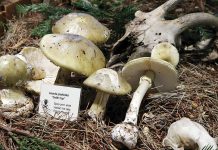
Last month’s column summarized the results of Audubon’s seven-year study on the effect of climate change and habitat loss on birds. The report was written by well-known scientists, but these highly regarded scientists could not have compiled all the data on bird locations and movements by themselves—such a task would be overwhelming. Where did Audubon’s scientists get the data needed to complete this study?
Surprisingly, much of the information needed for the study was compiled by regular people like you and me. Climate researchers and ornithologists (scientists who specialize in the study of birds) are increasingly relying on “citizen science” for data needed to conduct their studies. In fact, citizen scientists have been compiling and contributing data on birds for decades.
Prior to the turn of the century, Christmas bird shooting competitions were popular. Families gathered to celebrate the holiday would divide into two teams and the team shooting the most birds won the competition. With growing awareness of the need for conservation, an early Audubon member proposed that the “Christmas Side Shoot” become a “Christmas Bird Census.” What is now called the Christmas Bird Count started with 27 people counting birds and submitting their data to Audubon on Dec. 25, 1900.
Tens of thousands of people, including myself, now participate. For my first Christmas Bird Count, I apprenticed myself to two experienced birders. We spent an entire foggy day in early January driving up and down steep, muddy, roads, tromping up and down the hills on the back side of Coyote Ridge and getting generally cold, wet and exhausted in our effort to find and count birds. When we finished our assigned sector in the late afternoon we were given a second sector, as the people assigned to it had not been able to complete their count. It was dark when we finished, but I had seen and learned more than I’d ever hoped to and gotten the chance to explore some parts of South County not generally open to the public. The data we gathered was submitted to Audubon and became a small part of the “longest running citizen science survey in the world.” It felt good to know that I had helped, even in a teeny tiny way, contribute to this important database.
Audubon’s 115th annual Christmas Bird Count will take place from Dec. 14, 2014 to Jan. 5, 2015. Even if you are not an experienced birder, sometimes teams just need a “spotter,” a person to call out “there’s a bird!” Someone else can do the identification and counting. If you are interested, visit the Santa Clara Valley Audubon Society’s website at scvas.org/index.php?page=text&id=birding_citizenscience.
How can you count birds and be sure you aren’t counting the same individual over and over again? Most birds of the same species look pretty much alike, especially if you are looking at them from a distance with binoculars. The answer is to use a very strict set of protocols, carefully mapped out areas of study, and rigorous oversight. Those in charge of the bird count teams will know these protocols. Certainly, the count will not be accurate to the last individual bird, but by comparing results regarding the same species in the identical geographic area, over many years, trends appear.
In addition to the Christmas Bird Count, a joint project of the Cornell Lab of Ornithology and the National Audubon Society, called eBird, gathers data from birders about bird abundance and distribution. Cornell also hosts other citizen science events: Project Feeder Watch in winter, the Great Backyard Bird Count in February and Nest Watch in spring. You can find out how to participate in these events at birds.cornell.edu/page.aspx?pid=1664.
Our local Audubon Society has been compiling records of bird counts submitted by citizen scientists since the mid-1980s. Their comprehensive report, called the “Breeding Bird Atlas of Santa Clara County,” is a telephone book-size compilation of data on all birds breeding in the county from 1987 to 2005, but includes historic reports going back to the 1700s. Of the many interesting reports in the Atlas is the history of the burrowing owl, a species once common in the native grasslands of Santa Clara County. The bird has gradually disappeared, due to ground squirrel eradication (the birds nest in ground squirrel burrows) and development. There are now only a few areas where burrowing owls can be found, some of which have been specifically created for the owls and are managed by environmental organizations.
Observations from recreational bird watchers have given scientists an incredible amount of data, which scientists use to determine how birds are affected by habitat loss, pollution and climate change. The results have been used to create guidelines for birds and plan for the protection of declining species.














